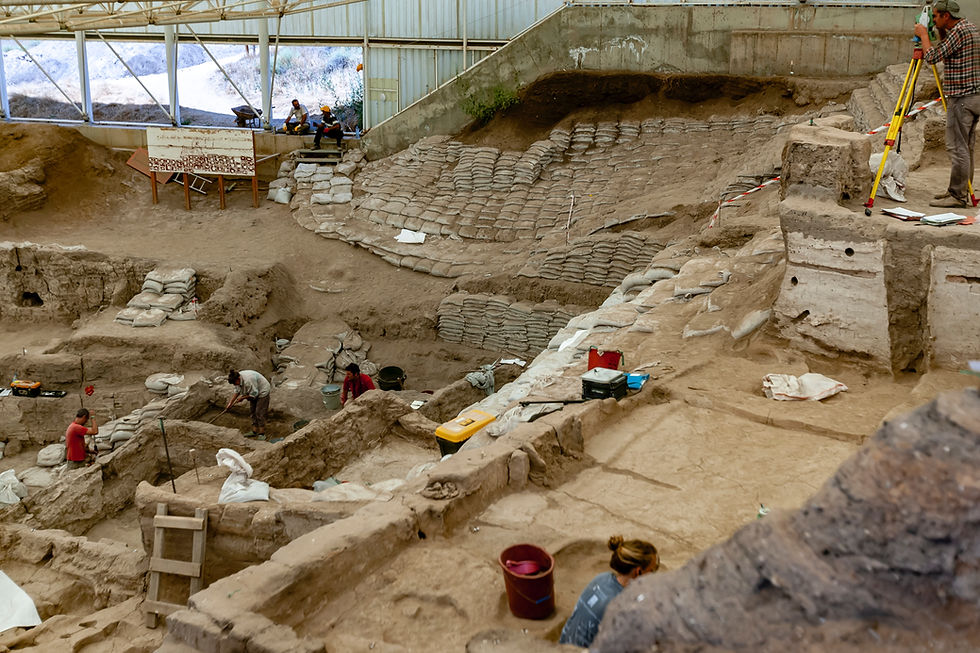Neolithic Skull Cults & Ritual Skulls
- Sylvia Rose

- Feb 28, 2024
- 5 min read
Skull cults appear in various forms from the Stone Ages. Early origins may be the Levant or Turkey, in a broad swath of similar ritual practices. Some may have risen independently of each other, as the collective human unconscious finds similar outlets of expression.
READ: Cult of the Fire God - Bronze Age Quest Adventure
See also:
Signs of the skull cult go back to c. 9600 BCE at least. Some theorists suggest an earlier date, c. 12,000. Plastered skulls, marked skulls, skulls on display and decapitated body interment for ritual purpose is found across cultures.
READ: Cult of the Fire God - Bronze Age Quest Adventure
Skulls are found defleshed after death, with paint or plaster applied directly to the bone. Plaster reconstructs the facial features. Colors of black, white and red are used most often in skull paint. Coincidentally these are the first three colors an infant can see after she's born.
See also:
In Neolithic times colors are close by. Black is made of soot or charcoal; white comes from limestone or chalk ground into pigment.
Early reds are made of crushed cochineal insects in Mesoamerica, the kermes insect in Eurasia, and red earth or ground hematite. In Africa, evidence of processing and use of red ochre pigments has been dated by archaeologists to c. 300,000 ya in the Middle Paleolithic.
See also:
The practice of plastering human skulls is widespread in the Pre-Pottery Neolithic B Levant, with examples from Jericho and 'Ain Ghazal. Modifications to skulls include replacing eyes with stones or cowrie shells, as in the Jericho skull dating to c. 7000 BCE.
The skull belongs to an adult male, and shows evidence of intentional cranial shaping. This is done when the person is a baby and the skull is still soft. In history skull shaping has been done by wrapping fabric or pressing a board against the skull.
See also:
The Jericho skull may belong to a person deemed special or significant from an early age. After the flesh and sinews decay, the skull is removed. Plaster is modelled over the front of the skull.
READ: Cult of the Fire God - Bronze Age Quest Adventure
Cranial deformation is also evident from several skulls of the Neolithic period, discovered at the Houtaomuga Site in Northeast China. Most have forehead or front skull modification, but there are other types too.
See also:
According to researchers, eleven skulls from both sexes show signs of intentional cranial modification (ICM). The deceased vary in age from juveniles to full adults. The skulls date from c. 9800 to c. 2800 BCE.
Three types of modification patterns are found. Most are fronto-occipital or forehead / front of face modification pattern. They show wide variations in the structure and curvature of the skull. The practice occurs cross-culturally.
See also:
By c. 10,000 - 8000 BCE, clay is an essential part of life. Early pottery emerges. Modeling human features from clay is one way to remember the dead. A much later way to preserve memories of loved ones is Victorian death photography.
Plastered or reworked skulls are displayed. The crania owners are powerful, perhaps in a spiritual way. One scholar suggests stigmatization of the individual after death. However removal and decoration seem to show esteem for the body, or at least the skull.
See also:
At skull cult sites, some burials contain headless skeletons. At Göbekli Tepe, a Neolithic archaeological site in southeast Turkey, no full burials are found. Signs of skull cult activity include three skulls deeply grooved with flint tools. One has a hole perfectly drilled.
It's possible skulls are hung or placed where they need reinforcement or hanging hardware, and the carved lines are for a practical purpose of less slippage. For instance the jaw might be attached with sinew or fiber. Another way of retaining the jaw is to pack it in with clay.
See also:
According to researcher Julia Gresky,
“The three modified skulls attest to special treatment of certain individuals and represent an entirely new category of find ... one which testifies to the interaction of the living with the dead at this important Early Neolithic ritual center."
Over 700 fragments of human remains at Gobekli Tepe offer an intriguing look into a previously unknown variation of the death ritual. The site is best known for monumental stone buildings, T-shaped limestone pillars, animal sculpture and carvings.
See also:
At Köşk Höyük, south central Turkey, almost a dozen ritual skulls are found. Some are covered with clay or plaster. These are the earliest individual molded skulls in Anatolia, with those from Çatalhöyük.
Painted red or black, the skulls of Köşk Höyük are displayed on clay platforms. One is that of a child. Of the rest, two are men, three are women and five indistinguishable. Most are young adults.
See also:
According to a booklet by the ministry of tourism and culture, the dead in the Kösk Höyük mound are often buried with their heads
"separated from the body, of which the faces were then plastered with clay and the facial features picked out in red paint, giving them a striking appearance. This practice is also evident between the years 10.000 to 8.000 BC in Palestine, Israel and the South of Syria."
See also:
At Kösk Höyük the skulls are removed when flesh has decomposed. They're then plastered and painted. The child's skull in Layer III provides important evidence in the debate about whether these skulls indicate veneration of the dead.
See also:













